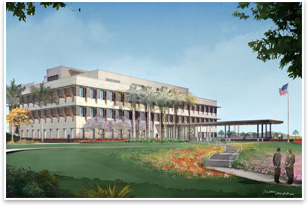
| U.S. Embassy in Panama Achieves Security and Sustainability EYP ties it all in a neat little package with a local flair
Summary: Balancing the twin rigors of security and sustainability, the new U.S. Embassy in Panama City, Panama, has earned LEED® certification from the U.S. Green Building Council. Designed by Einhorn Yaffee Prescott, Architecture & Engineering PC, the Panamanian facility is only the second American embassy to achieve LEED certification. Located on a 43-acre sloping site, the $69 million embassy was designed to consolidate and replace aging facilities that were disbursed throughout Panama City, says James Ball, LEED-AP, EYP project director. “The new embassy enabled the government to consolidate all the facilities into one compound that is designed to today’s safety standards,” Ball explains. “The new embassy will enable the government to serve the citizens of Panama quicker and in a more comfortable facility.” Completed in June 2007, the embassy includes two kilometers (1.24 miles) of perimeter wall and fences; three compound access control facilities; a four-story chancery building with 110 desks; a two-story Marine security guard quarters; a utility building; a warehouse; a support annex; recreation facilities that include a pool, basketball court, tennis court, and cabana; and parking for 290 vehicles. The chancery building measures more than 150,000 square feet. In the vernacular Sustainable considerations The use of low-flow bathroom fixtures has reduced water consumption for irrigation by 50 percent and for potable water by 32 percent. Energy efficiency measures include roof insulation, lighting controls, and HVAC standards, resulting in energy consumption levels 28 percent improved over ASHRAE guidelines. More than 32 percent of the building materials were produced within 500 miles of the project site, and efficient waste collection and dedicated recycling facilities were integral to the building design. The building’s indoor environment is monitored to provide the highest air quality possible. Finally, the embassy provides an educational program for the inhabitants, explaining the integration of security and sustainable design strategies, technologies, and benefits so they may better understand how design decisions affect their personal environment. Balancing security with sustainability “To achieve a LEED-certified building, the owner, builder, and design team must plan ahead,” Ball explains. “The Department of State, along with EYP AE, developed a LEED score card that is now incorporated into each new embassy compound contract. This score card rates each possible point as recommended, alternate, optional, or N/A. The points that are sought avoid costly or difficult details.” Ball notes that the architect must bear in mind the difficulties of building a secure facility in a foreign country throughout the design process. “You must remember where the project is being built, how the contractor is going to be getting materials to the site, and who is doing the work,” he says. “It is not like designing a project in New York City, or any other U.S. city. The entire team must select early in the planning phase which LEED points are going to be attempted to avoid costly or difficult points.” |
||
Copyright 2008 The American Institute of Architects. All rights reserved. Home Page |
||
news headlines
practice
business
design
recent related
› Holl-designed Swiss Embassy Garners RIBA Award
› Einhorn Yaffee Prescott’s Katzen Arts Center Really Performs
› Lutyens’ British Embassy Celebrates 75 Years
Rendering courtesy of Einhorn Yaffee Prescott, Architecture & Engineering PC
To learn what’s happening with the Justice Architecture Knowledge Community, visit AIA.org.
At the AIA Bookstore: Building Type Basics for Justice Facilities, by Todd S. Phillips & Michael A. Griebel

 How do you . . .
How do you . . .